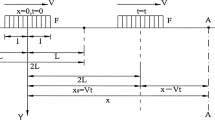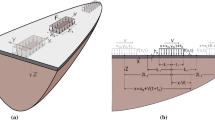Abstract
The problem of determining the dynamic response of a granular elastic half-space soil medium to a rectangular load moving on its surface is determined analytically. The granular material is modeled as a gradient elastic solid with two material constants in addition to the two classical elastic moduli. These material constants with dimensions of length are the micro-stiffness g and the micro-inertia h coefficients. The rectangular load is uniformly distributed of constant magnitude and moves with constant speed. The resulting three partial differential equations of motion are of the fourth order with respect to the horizontal x, y, and vertical z coordinates and of second order with respect to time t. These equations are solved with the aid of double complex Fourier series involving x, y, t, and the load velocity, which reduce them to a system of three ordinary differential equations of the fourth order with respect to z, which can be easily solved. Use of appropriate classical and non-classical boundary conditions can lead to the solution of the problem. The so obtained solution is used to easily assess by parametric studies the effects of the microstructural parameters g and h as well as the moving load velocity on the various response quantities.







Similar content being viewed by others
References
Beskou, N.D., Theodorakopoulos, D.D.: Dynamic effects of moving load pavements: a review. Soil Dyn. Earthq. Eng. 31, 547–567 (2011)
Eason, G.: The stresses produced in semi-infinite solid by a moving surface force. Int. J. Eng. Sci. 2, 581–609 (1965)
Payton, R.G.: Transient motion of an elastic half-space due to a moving surface line load. Int. J. Eng. Sci. 5, 49–79 (1967)
Gakenheimer, D.C., Miklowitz, J.: Transient excitation of an elastic half space by a point load traveling on the surface. J. Appl. Mech. ASME 36, 505–515 (1969)
De Barros, F.C.P., Luco, J.E.: Stresses and displacements in a layered half-space for a moving line load. Appl. Math. Comput. 67, 103–134 (1995)
Jones, D.V., Le Houedec, D., Peplow, A.D., Petyt, M.: Ground vibration in vicinity of a moving rectangular load on a half-space. Eur. J. Mech. A/Solids 17, 153–166 (1998)
Grundmann, H., Lieb, M., Trommer, E.: The response of a layered half-space to traffic loads moving along its surface. Arch. Appl. Mech. 69, 55–67 (1999)
Georgiadis, H.G., Lykotrafidis, G.: A method based on the Radon transform for three-dimensional elastodynamic problems of moving loads. J. Elast. 65, 87–129 (2001)
Liao, W.I., Teng, T.J., Yeh, C.S.: A method for the response of an elastic half-space to moving sub-Rayleigh point loads. J. Sound Vib. 284, 173–188 (2005)
Cao, Y.M., Xia, H., Lombaert, G.: Solution of moving- load- induced soil vibrations based on the Betti-Rayleigh dynamic reciprocal theorem. Soil Dyn. Earthq. Eng. 30, 470–480 (2010)
Ba, Z., Liang, J., Lee, V.W., Ji, H.: 3D dynamic response of a multi-layered transversely isotropic half-space subjected to a moving point load along a horizontal straight line with constant speed. Int. J. Solids Struct. 100–101, 427–445 (2016)
Beskou, N.D., Muho, E.V., Qian, J.: Dynamic analysis of an elastic plate on a cross-anisotropic elastic half-space under a rectangular moving load. Acta Mech. 231, 4735–4759 (2020)
Muho, E.V.: Dynamic response of an elastic plate on a transversely isotropic viscoelastic half-space with variable with depth moduli to a rectangular moving load. Soil Dyn. Earthq. Eng. 139, 106330 (2020)
Mindlin, R.D.: Micro-structure in linear elasticity. Archiv. Ration. Mech. Anal. 16, 51–78 (1964)
Georgiadis, H.G.: The mode III crack problem in microstructured solids governed by dipolar gradient elasticity; static and dynamic analysis. J. Appl. Mech. ASME 70(4), 517–530 (2003)
Zhou, D., Jin, B.: Boussinesq–Flamant problem in gradient elasticity with surface energy. Mech. Res. Commun. 30, 463–468 (2003)
Li, S., Miskioglu, I., Altan, B.S.: Solution to line loading of a semi-infinite solid in gradient elasticity. Int. J. Solids Struct. 41, 3395–3410 (2004)
Giannakopoulos, A.E.: A reciprocity theorem in linear gradient elasticity and corresponding Saint-Venant principle. Int. J. Solids Struct. 44, 346–572 (2007)
Georgiadis, H.G., Anagnostou, D.S.: Problems of the Flamant-Boussinesq and Kelvin type in dipolar gradient elasticity. J. Elast. 90, 71–98 (2008)
Papargyri-Beskou, S., Polyzos, D., Beskos, D.E.: Wave dispersion in gradient elastic solids and structures: a unified treatment. Int. J. Solids Struct. 46(21), 3751–3759 (2009)
Gao, X.L., Zhou, S.S.: Strain gradient solutions of half-space and half-plane contact problems. Z Angew. Math. Phys. 64, 1363–1386 (2013)
Georgiadis, H.G., Gourgiotis, P.A., Anagnostou, D.S.: The Boussinesq problem in dipolar gradient elasticity. Arch. Appl. Mech. 84, 1373–1391 (2014)
Papargyri-Beskou, S., Tsinopoulos, S.: Lamé’s strain potential method for plane gradient elasticity problems. Arch. Appl. Mech. 85(9–10), 1399–1419 (2015)
Lazar, M., Polyzos, D.: On non-singular crack fields in Helmholtz type enriched elasticity theories. Int. J. Solids Struct. 62, 1–7 (2015)
Polyzos, D., Huber, G., Mylonakis, G., Triantaffylidis, T., Papargyri-Beskou, S., Beskos, D.E.: Torsional vibrations of a column of fine-grained material: a gradient elastic approach. J. Mech. Phys. Solids 76, 338–358 (2015)
Gavardinas, I.D., Giannakopoulos, A.E., Zisis, T.: A von Karman plate analogue for solving anti-plane problems in couple stress and dipolar gradient elasticity. Int. J. Solids Struct. 148–149, 169–180 (2018)
Pegios, I.P.S., Zhou, Y., Papargyri-Beskou, S., He, P.: Steady-state dynamic response of a gradient elastic half-plane to a load moving on its surface with constant speed. Arch. Appl. Mech. 89, 1809–1824 (2019)
Siddharthan, R., Zafir, Z., Norris, G.M.: Moving load response of layered soil. I: formulation; II: verification and application. J. Eng. Mech. 119(10), 2052–2071 (1993)
Theodorakopoulos, D.D.: Dynamic analysis of a poroelastic half-plane soil medium under moving loads. Soil Dyn. Earthq. Eng. 23, 521–533 (2003)
Suiker, A.S.J., Metrikine, A.V., De Borst, R.: Dynamic behavior of a layer of discrete particles, Part 2: response to a uniformly moving, harmonically vibrating load. J. Sound Vib. 240(1), 19–39 (2001)
Mathematica, Version 4.1, Wolfram Research Inc., Champaign, IL, USA, 2004.
Acknowledgements
The authors are grateful to the Department of Disaster Mitigation for Structures, College of Civil Engineering, Tongji University, Shanghai 200092, China, for supporting this work.
Author information
Authors and Affiliations
Corresponding author
Ethics declarations
Conflict of interest
On behalf of all authors, the corresponding author states that there is no conflict of interest.
Additional information
Publisher's Note
Springer Nature remains neutral with regard to jurisdictional claims in published maps and institutional affiliations.
Appendices
Appendix 1
For n = 0 and m = 0, Eqs. (27), (28), and (29) become
Equation (48) has the same characteristic equation
Thus, the solutions of the above equations read
From the classical boundary conditions of Eqs. (13) and (14), we obtain
From the non-classical boundary conditions of Eq. (15), we have
Finally, from the three displacements boundary conditions of Eqs. (16) and (17), we obtain
By substituting Eqs. (50, 51, 52) to Eqs. (53, 54), we obtain the final values of the coefficients \({A}_{i}\), \({B}_{i}\), \({C}_{i}\) (\(i=1-4\)) which are of the form
From Eqs. (50) and (55), we obtain the final solutions in the form
We can observe that for g = 0 we obtain the classical solution, which reads
The solution (57) is the same as the solution (60) given in Beskou et al. [12].
Appendix 2
For n = 0 and m > 0, Eqs. (27, 28, 29) become
where
Solutions of the system of Eqs. (58), (59), and (60) are assumed to be of the form
Substitution of the above solutions (62) into the system of Eqs. (58), (59), and (60) results in the equation
For nonzero solutions of the system of Eq. (63), the following algebraic equation should be satisfied:
Equation (64) is solved for its 12 roots \(q_{k} { }\left( {k = 1,2, \ldots 12} \right).{ }\) Thus, the solutions (62) can take the final form
where \(\lambda_{1}\) and \(\lambda_{2}\) are the two roots of the equation \(a_{3} q^{2} + a_{2} q + a_{1} = 0\), and S0mk, T0mk are the values of S0m and T0m for the qk, respectively. By assuming S0mk known, one obtains from (65)
with
The displacements now take the forms
In the above, there are 12 constants (8 S0mk, k = 1–8 and 4 \(R_{0mi}\), i = 1–4) to be determined from the 12 boundary conditions. These boundary conditions are given by Eqs. (13), (14), (15), (16), and (17), which after the substitution of the displacements from (68) reduce to the following algebraic system of equations:
where \({\overline{B} }_{1k}-{\overline{B} }_{8k}\) can be obtained from Eq. (46) by setting \({\lambda }_{n}\)=0 and considering that \({\overline{B} }_{1k}={B}_{2k}\), \({\overline{B} }_{2k}={B}_{3k}\), \({\overline{B} }_{3k}={B}_{5k}\), \({\overline{B} }_{4k}={B}_{6k}\), \({\overline{B} }_{5k}={B}_{8k}\), \({\overline{B} }_{6k}={B}_{9k}\), \({\overline{B} }_{7k}={B}_{11k}\), and \({\overline{B} }_{8k}={B}_{12k}\).
After solving Eqs. (69), (70), (71), and (72) for \({R}_{0mi}\) and \({S}_{0mk}\), one can compute \({U}_{0m}\), \({V}_{0m}\), and \({W}_{0m}\) from Eq. (65) and finally the displacements uy (x, y, z, t) and uz (x, y, z, t) from Eq. (68). For g = h = 0, we find the classical case, which is the same as that given in Appendix B in Beskou et al. [12].
Appendix 3
For n > 0 and m = 0, Eqs. (27), (28), and (29) become
where
Solutions of the system of Eqs. (73), (74), and (75) are assumed to be of the form
Substitution of the above solutions (77) into the system of Eqs. (73), (74), and (75) results in the equation
For nonzero solutions of the system of Eq. (78), the following algebraic equation should be satisfied:
Equation (79) is solved for its 12 roots \(q_{k} \left( {k = 1,2, \ldots 12} \right). \) Thus, the solutions (77) can take the final form
where \(\lambda_{1}\) and \(\lambda_{2}\) are the two roots of the equation \(b_{5} q^{2} + b_{2} q + b_{1} = 0\), and \(R_{n0k} , T_{n0k}\) are the values of \(R_{n0}\), and \(T_{n0}\) for the \(q_{k}\), respectively.
By assuming R0mk known, one obtains from (80)
with
The displacements now take the forms
In the above, there are 12 constants (8 \({R}_{n0k}\), k= 1–8 and 4 \({S}_{noi}\), i = 1–4) to be determined from the 12 boundary conditions. These boundary conditions are given by Eqs. (13), (14), (15), (16), and (17), which after the substitution of the displacements from (83) reduce to the following algebraic system of equations:
where \({\stackrel{-}{\overline{B}} }_{1k}\) – \({\stackrel{-}{\overline{B}} }_{8k}\) can be obtained from Eq. (46) by setting \({\mu }_{m}\)=0 and considering that \({\stackrel{-}{\overline{B}} }_{1k}={B}_{1k}\), \({\stackrel{-}{\overline{B}} }_{2k}={B}_{3k}\), \({\stackrel{-}{\overline{B}} }_{3k}={B}_{4k}\), \({\stackrel{-}{\overline{B}} }_{4k}={B}_{6k}\), \({\stackrel{-}{\overline{B}} }_{5k}={B}_{7k}\), \({\stackrel{-}{\overline{B}} }_{6k}={B}_{9k}\), \({\stackrel{-}{\overline{B}} }_{7k}={B}_{10k}\), and \({\stackrel{-}{\overline{B}} }_{8k}={B}_{12k}\).
After solving Eqs. (84), (85), (86), and (87) for \({S}_{noi}\) and \({R}_{n0k}\), one can compute \({U}_{n0}\), \({V}_{n0}\), and \({W}_{n0}\) from Eq. (80) and finally the displacements ux (x, y, z, t) and uz (x, y, z, t) from Eq. (83). For g = h = 0, we find the classical case, which is the same as that given in Appendix C in Beskou et al. [12].
Rights and permissions
About this article
Cite this article
Muho, E.V., Pegios, I.P., Zhou, Y. et al. Dynamic response of a gradient elastic half-space to a load moving on its surface with constant speed. Acta Mech 232, 3159–3178 (2021). https://doi.org/10.1007/s00707-021-03003-7
Received:
Revised:
Accepted:
Published:
Issue Date:
DOI: https://doi.org/10.1007/s00707-021-03003-7




